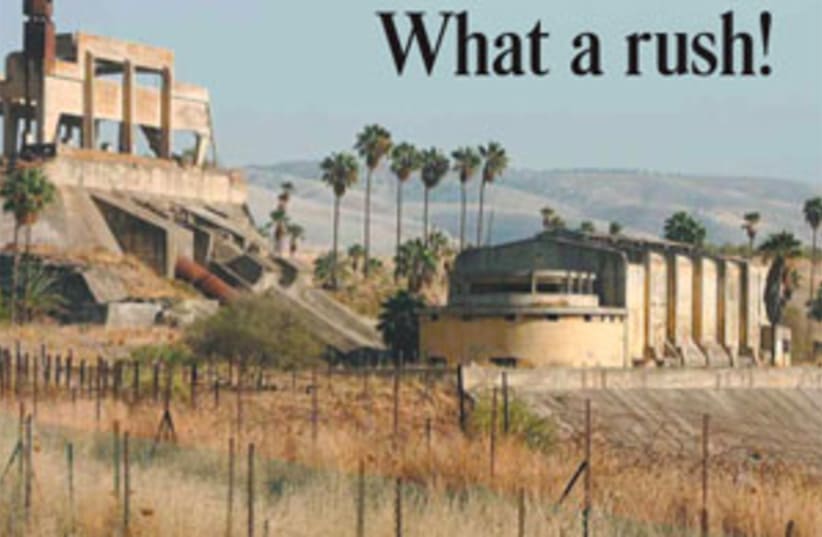Today, a visit to the Isle of Peace requires the presence of a guide from Ashdot Ya'acov, the kibbutz that runs a kiosk at Naharayim and oversees the memorial garden and picnic site dedicated to the seven young victims. Although you enter the enclave by vehicle, you get out several times to watch Israeli settlers working the land, to view the remains of an unusual railroad station and the deserted lake, and tolearn about the ingenious electrical plant built here by Pinhas Rutenberg nearly 80 years ago. You willalso cross several bridges that Jewish forces blew up during the War of Independence to limit themovements of Iraqi forces.
Other attractions at Naharayim include a lovely overlook and a walk along a path that leads towards the two rivers (naharayim) for which the site is named. If you come now, after this winter's blessed rainfall, you will find the waters tumultuously churning: an awesome sight that I have heard (Israeli) visitors liken to Niagara Falls.KNOWN AS both the Old Man of Naharayim and the Father of Israeli electricity, Pinhas Rutenberg was born in Czarist Russia in 1879. He was a fiery revolutionary who served for a short time in the provisional government after the ousting of the Czar, but he was imprisoned when radical Bolsheviks took over the country in October of 1917. At some point, he was transformed from an assimilated Jew into a fervent Zionist and upon his release in 1918, he headed for the Land of Israel.An innovative hydraulic engineer with a genius for organization, he carried out a thorough survey and developed an ambitious plan for establishing power stations all over the country. Rutenberg asked the British mandatory government for a concession to Palestine's water sources so that he could build the dams and power plants he'd envisioned, but found himself faced with stiff opposition.
Adversaries included Arabs, assorted anti-Zionists and detractors who vilified him as a communist because of his Russian revolutionary background and said he couldn't be trusted.
But the multitalented Rutenberg didn't faze easily. He persisted, and in 1921, he was granted a 70-year concession to generate electricity by harnessing many of the water sources in Palestine. Soon afterwards, he began working on an enormous project: the first big hydro-electric power station in Israel.His new power station was to be located near the southern edge of the Sea of Galilee, at the point where the Yarmuk River meets the fabled Jordan. Here Rutenberg could take advantage of the Yarmuk's heavy flow during floods. And he would also borrow from the perennial waters of the Jordan, which is fed from the Kinneret and springs in the Jordan Valley.Rutenberg used a system of dams and channels to regulate the flow of water to his power plant. There was also a lake, now an enormous empty pit filled with foliage, which stored water for the summer months when the Yarmuk's flow isn't very strong.DURING YOUR tour of the Isle of Peace, you will stand next to a security fence and gaze at the exterior of the once magnificent power plant and its three large pipes. Water from the lake flowed into the 'Zero Canal,' eventually reaching the pipes and dropping sharply 27 meters to the turbines inside the plant. The force of the water activated the turbines of the power plant to create electricity for the entire north of Israel. It continued to operate until it was knocked out by Iraqi forces during the War of Independence.There were two neighborhoods at Naharayim, one for Rutenberg and his clerks and engineers, and another for the workers. Rutenberg didn't believe in unions, but he provided his workers with medical care, schooling, food and a place to live.Building on the plant began in 1927, and all was ready at the beginning of 1931. On February 13, 1931, however, there was a huge flood and the canal burst. Water flooded the power plant and sent a 60-ton turbine floating down south. Everything in the plant was devastated.Workers were terrified that their cushy new lives were threatened, and offered to rebuild the entire site for only room and board. Rutenberg agreed - but insisted on paying salaries as well. A second February passed with no damage, and on March 9, 1932, the new turbines began to operate. Naharayim, which connected the entire north with the country's first electric network, had begun to roll.Your guide will point out a shed, all that remains of the fabulous Rotenberg villa in which Golda Meir met with King Abdullah in November 1947. In 1969, after Arab terrorists used the house as a base for launching attacks on Israel, it was blown up by the Israeli army.Out here, in the middle of nowhere, you suddenly come to a railroad station. Back in 1905, and for the next 40- odd years, a train ran from Haifa to Damascus. In the 1930s and '40s, it had a stop at Naharayim. Like the power station, the railroad station was built with Jewish labor. It was designed in Bauhaus style, with a lack of ornamentation, rounded corners and long, horizontal lines.The train was said to be so slow that you could jump off, pick a bouquet of wildflowers (or make a pit stop) and climb back on without missing a beat. And it was often late, which led annoyed passengers to leave graffiti on the walls. On April 1, 1939, one of them scrawled the Hebrew equivalent of 'Where the heck is the train?'A tour of the island costs NIS 20 per person. The 'dam walk' is NIS 7. The memorial garden, picnic sites and overlooks are free. Naharayim is off highway 90, south of Kibbutz Ashdot Ya'acov and across from Menahemya.| More about: | Hussein of Jordan, Golda Meir, Russian Empire, Beit Shemesh |
